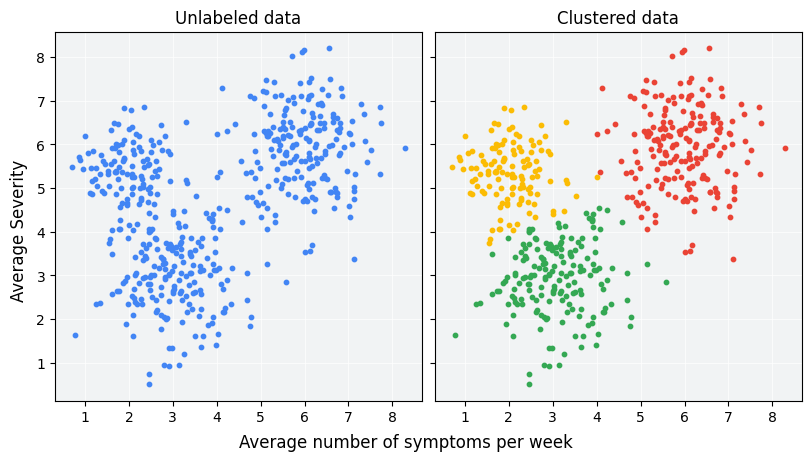의료 시스템의 환자 정보가 포함된 데이터 세트를 사용하고 있다고 가정해 보겠습니다. 데이터 세트는 복잡하며 범주형 특성과 숫자형 특성이 모두 포함되어 있습니다. 데이터 세트에서 패턴과 유사성을 찾으려고 합니다. 이 작업을 어떻게 처리하시겠어요?
클러스터링은 서로의 유사성을 기반으로 라벨이 지정되지 않은 예를 그룹화하도록 설계된 비지도 머신러닝 기법입니다. 예시가 라벨이 지정된 경우 이러한 종류의 그룹을 분류라고 합니다. 새로운 치료 프로토콜을 평가하기 위해 설계된 가상의 환자 연구를 생각해 보겠습니다. 연구 기간 동안 환자는 주당 증상이 발생하는 빈도와 증상의 심각도를 보고합니다. 연구원은 클러스터 분석을 사용하여 유사한 치료 반응을 보이는 환자를 클러스터로 그룹화할 수 있습니다. 그림 1은 시뮬레이션된 데이터를 세 개의 클러스터로 그룹화하는 한 가지 방법을 보여줍니다.

그림 1의 왼쪽에 있는 라벨이 지정되지 않은 데이터를 보면 데이터 포인트 간의 유사성에 대한 공식적인 정의가 없어도 데이터가 세 개의 클러스터를 형성한다고 추측할 수 있습니다. 그러나 실제 애플리케이션에서는 데이터 세트의 기능을 기준으로 유사성 측정값 또는 샘플을 비교하는 데 사용되는 측정항목을 명시적으로 정의해야 합니다. 예시가 몇 가지 특징만 가지고 있는 경우 유사성을 시각화하고 측정하는 것은 간단합니다. 하지만 기능 수가 늘어나면 기능을 결합하고 비교하는 것이 직관적이지 않고 더 복잡해집니다. 클러스터링 시나리오에 따라 적절한 유사성 측정값이 다를 수 있으며, 이 과정에서는 뒷부분의 수동 유사성 측정값 및 임베딩의 유사성 측정값 섹션에서 적절한 유사성 측정값을 선택하는 방법을 설명합니다.
클러스터링 후 각 그룹에는 클러스터 ID라는 고유한 라벨이 할당됩니다. 클러스터링은 많은 특성이 있는 크고 복잡한 데이터 세트를 단일 클러스터 ID로 간소화할 수 있으므로 강력합니다.
클러스터링 사용 사례
클러스터링은 다양한 업계에서 유용합니다. 클러스터링의 몇 가지 일반적인 애플리케이션은 다음과 같습니다.
- 시장 세분화
- 소셜 네트워크 분석
- 검색 결과 그룹화
- 의료 영상
- 이미지 세분화
- 이상 감지
클러스터링의 구체적인 예는 다음과 같습니다.
- 허츠스프룽-러셀 다이어그램은 밝기와 온도별로 표시된 별 모임을 보여줍니다.
- 이전에는 알려지지 않았던 종 간의 유전적 유사성과 차이를 보여주는 유전자 시퀀싱으로 인해 이전에 외관을 기반으로 했던 분류가 수정되었습니다.
- 성격의 5대 요인 모델은 성격을 설명하는 단어를 5개 그룹으로 클러스터링하여 개발되었습니다. HEXACO 모델은 5개가 아닌 6개의 클러스터를 사용합니다.
대치
클러스터의 일부 예시에서 지형지물 데이터가 누락된 경우 클러스터의 다른 예시에서 누락된 데이터를 추론할 수 있습니다. 이를 추정이라고 합니다. 예를 들어 인기가 낮은 동영상을 인기가 높은 동영상과 함께 클러스터링하여 동영상 맞춤 콘텐츠를 개선할 수 있습니다.
데이터 압축
앞서 설명한 대로 관련 클러스터 ID는 해당 클러스터의 모든 예시에서 다른 기능을 대체할 수 있습니다. 이러한 대체는 특성 수를 줄여주므로 해당 데이터에 관한 모델을 저장, 처리, 학습하는 데 필요한 리소스도 줄어듭니다. 대규모 데이터 세트의 경우 이러한 절감 효과가 상당합니다.
예를 들어 단일 YouTube 동영상에는 다음과 같은 지형지물 데이터가 포함될 수 있습니다.
- 시청자 위치, 시간, 인구통계
- 댓글 타임스탬프, 텍스트, 사용자 ID
- 동영상 태그
YouTube 동영상을 클러스터링하면 이 기능 집합이 단일 클러스터 ID로 대체되어 데이터가 압축됩니다.
개인 정보 보호
사용자를 클러스터링하고 사용자 ID 대신 클러스터 ID로 사용자 데이터를 연결하여 어느 정도 개인 정보를 보호할 수 있습니다. 예를 들어 YouTube 사용자의 시청 기록을 기반으로 모델을 학습시키고자 한다고 가정해 보겠습니다. 사용자 ID를 모델에 전달하는 대신 사용자를 클러스터링하고 클러스터 ID만 전달할 수 있습니다. 이렇게 하면 개별 시청 기록이 개별 사용자에게 연결되지 않습니다. 개인 정보를 보호하려면 클러스터에 충분히 많은 수의 사용자가 포함되어야 합니다.
